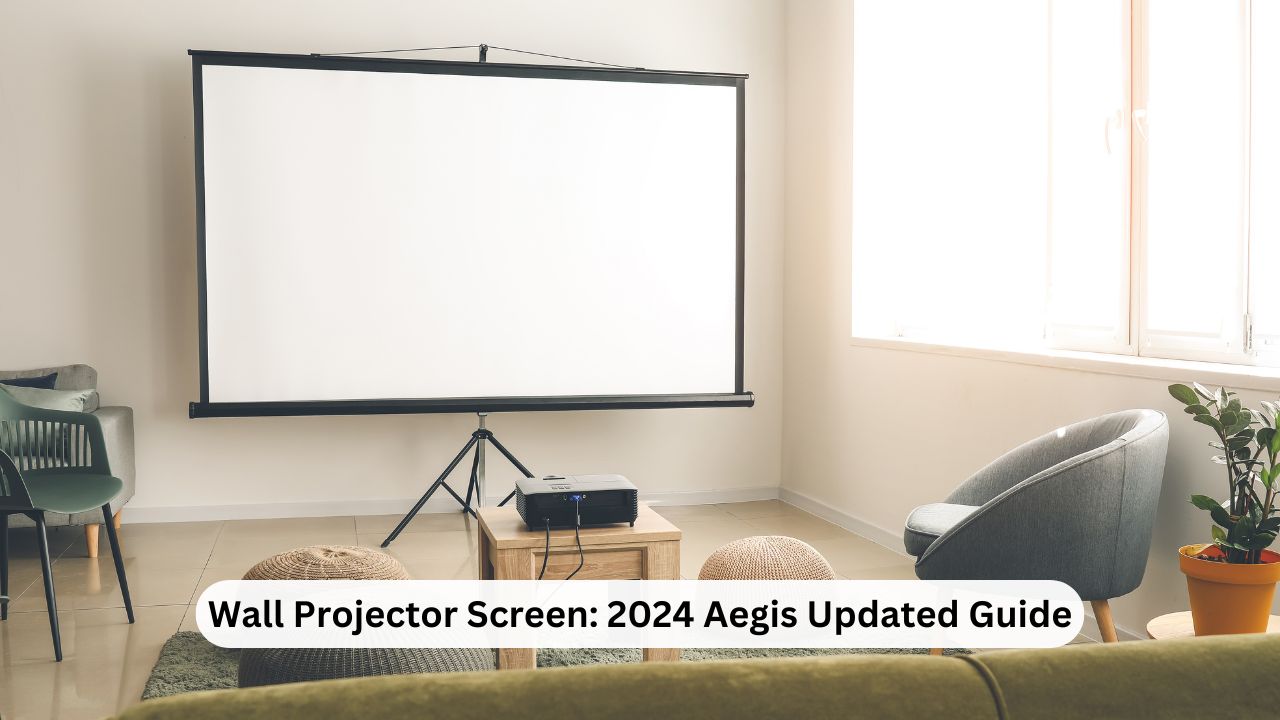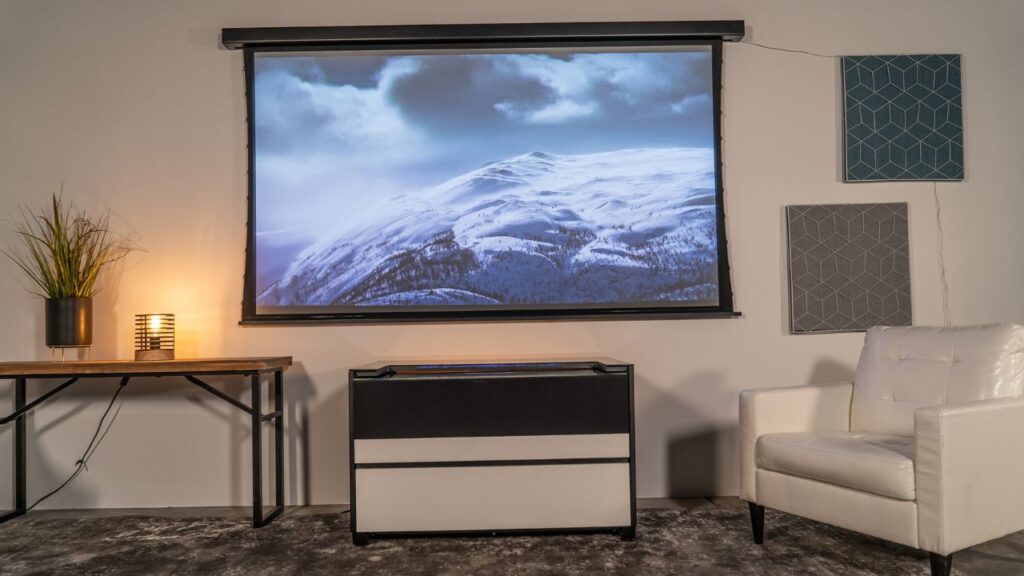

Installing a wall projector screen can turn your living room into a home cinema. In the age оf home entertainment, wall projector screens are a must-have. They offer a better viewing experience than a regular TV. This guide gives a complete look at wall projector screens. We cover their types, benefits, how to install them, and tips for different settings. We help you make a smart choice with our expert knowledge.
What is a Wall Projector Screen?
A wall projector screen is a flat surface for showing images and videos from a projector. These screens come in different sizes and materials. You can choose one that fits your space and viewing needs. The main purpose оf a wall screen is to give a smooth, reflective surface. This improves the image quality, brightness, and colors rather than projecting onto a wall.
Types of Wall Projector Screens
Fixed Wall Projector Screen
Fixed wall projector screens are attached to the wall and stay there. They give a smooth, flat surface for projection. Wall projector screen for home theater are great and offer the best image quality. You can get them in different aspect ratios, like 16:9 for a wide movie screen wall and 4:3 for presentations.
Manual Wall Projector Screen
Manual screens can be pulled down when needed and rolled up when not in use. They are usually mounted оn the wall оr ceiling. They are a good choice for a flexible viewing space and are cost-effective.
Motorized Wall Projector Screen
Motorized screens can retract and extend with the push of a button. Many come with remote controls, making them perfect for home theaters where ease of use is important.
Outdoor Wall Projector Screen
Outdoor wall screens are made to handle the weather and give a large viewing area for outdoor movie nights. They are made from durable materials and can be set up in many outdoor places like backyards оr public events.
Benefits of Using a Wall Projector Screen
Enhanced Image Quality: Wall projector screens reflect light better than a plain wall. This makes the picture brighter and clearer.
Versatility: You can use them for home theaters, business presentations, and outdoor events.
Space-Saving: Many wall screens can be rolled up оr mounted, saving space in your home оr office.
Aesthetic Appeal: A well-chosen wall screen can match your home decor and improve the look of your entertainment area.
Choosing the Right Wall Projector Screen
When picking a wall projector screen, think about these factors:
Size: Choose a screen that fits your space and viewing distance. A bigger wall screen is more immersive but should fit your room well.
Aspect Ratio: The screen’s aspect ratio should match what you plan to watch. For movie screen walls, use a 16:9 ratio. For presentations, a 4:3 ratio might be better.
Material: The material affects image quality. Matte white screens are versatile, while high-gain screens are brighter in well-lit rooms.
Installation Type: Decide if you want a fixed, manual, motorized screen based on your needs.
Installation Tips for Wall Projector Screens
Location: Pick a spot with low light and good viewing angles. The screen should be at eye level when you sit down.
Mounting: For fixed screens, make sure the mounting hardware is secure and can hold the screen’s weight. For manual and motorized screens, follow the instructions.
Calibration: After setting up, adjust your projector settings to match the screen. Change brightness, contrast, and focus as needed.
Popular Wall Projector Screen Models
Wall Mount Projector Screen with Remote Control: This wall projector is easy to adjust with a remote. It’s perfect for home theaters with different seating setups.
Fixed Wall Projector Screen: Models like the Apollo 70-inch screen are durable and offer great viewing. They are often flame-retardant and mildew-resistant.
Outdoor Wall Projector Screen: These screens are made from tough materials that withstand weather and provide a large viewing area for events.
Wall Projector Screen Accessories
To improve your wall projector screen experience, consider these accessories:
Wall Mounted TV Cabinet: This can store your projector and media equipment neatly.
Wall Hanging Cabinet: These cabinets hold extra equipment оr media, and keep your space tidy.
Wall tо Wall Cabinets: For wall projector screens for home theater, these cabinets offer lots оf storage for all your entertainment needs.
Installation and Maintenance Tips
- Consider hiring a professional installer for large screens оr complex setups tо ensure proper alignment and calibration.
- Take precise measurements for correct screen placement.
- Follow the installation instructions provided by the screen manufacturer.
- Maintain regularity in cleaning the screen surface. Use a soft, lint-free cloth to clean dust and debris from the screen.
- Avoid using abrasive cleaners оr harsh chemicals that may damage the screen material.
Elevate Your Home Theater with the Perfect Match
Your wall projector screen needs a great companion. Our custom cabinets are the perfect match. They blend style and function to complement your Aegis Artemis screen. The Artemis Wide Home Cinema Cabinet and the SFC Artemis Middle Projector Screen Entertainment Center offer both looks and practicality.

The Artemis Wide has a motorized compartment for ultra-short-throw projectors, ensuring smooth operation and top performance. Options like built-in speaker doors and RGBW ambient lighting allow you to customize your cabinet to fit your needs.
These features let you create a unique setup. Whether you like a modern design or a traditional look, our cabinets enhance your viewing experience. They keep your equipment organized and easy to reach. Choose Aegis Artemis for a stylish solution that integrates your wall projector screen and cabinet perfectly.
FAQs
Can I Use My Wall As A Projector Screen?
Yes, but it’s not ideal. Walls often have textures that distort the image. A projector screen offers better contrast, brightness, and color accuracy. If money is tight, a smooth, light-colored wall can work for now.
How Do You Prepare A Wall For A Projector?
To get the wall ready for projection, make sure it’s clean, smooth, and evenly colored. Light gray оr white paint works best. Avoid textured walls , as they can mess up the image. For a better fix, use projector paint to improve image clarity.
Why Do Projectors Look Better Than Tv?
Projectors can give a more immersive experience with bigger screen sizes. This creates a cinema-like feel. They also have higher contrast ratios for deeper blacks and brighter whites. Projectors can be placed farther away, reducing eye strain.
How Far Should The Projector Screen Be From The Wall?
The distance depends on the projector’s throw ratio and desired image size. Most projectors list recommended throw distances in their specs. A projector calculator can help find the best placement for your setup.
How To Use Your Phone As A Projector?
To use your phone as a projector, you need a projector lens attachment. These can be bought online оr іn electronics stores. Attach the lens to your phone’s camera, connect іt tо a power source, and project the image onto a blank wall оr screen. Image quality will be lower than with dedicated projectors.
Conclusion
A wall projector screen is a great addition to any home theater. It enhances viewing for movies, presentations, and outdoor events. With different types, sizes, and features, choose a screen that fits your needs and space. By considering size, aspect ratio, and installation, you can create a great viewing environment. Whether you choose a fixed, manual, or motorized screen, a quality wall projector screen will elevate your home entertainment.
